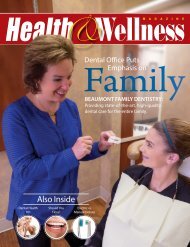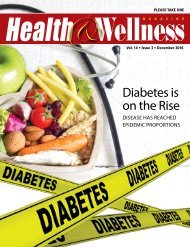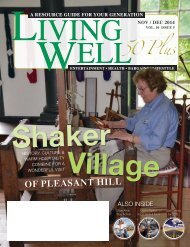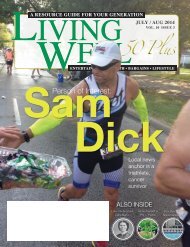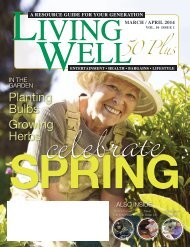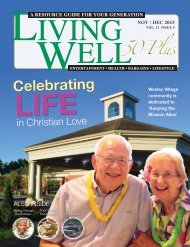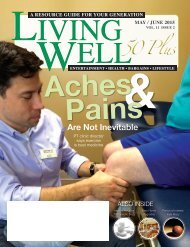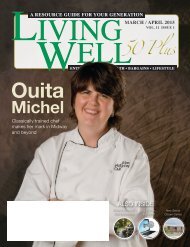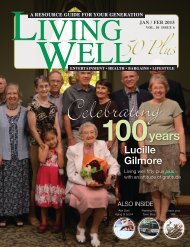Living Well 60+ September-October 2014
You also want an ePaper? Increase the reach of your titles
YUMPU automatically turns print PDFs into web optimized ePapers that Google loves.
SEPT/OCT 2 0 1 4<br />
A Snapshot of<br />
Caregiving Today<br />
Who are the caregivers?<br />
Who are the care receivers?<br />
1 3<br />
by Lisa M. Petsche, Staff Writer<br />
In approximately 30 percent of<br />
American households, unpaid care<br />
is regularly provided to someone<br />
who is chronically ill, disabled or<br />
aged and whose ability to carry out<br />
activities of everyday life is compromised.<br />
It’s not necessary to live under the<br />
same roof as the person one is helping<br />
or to provide assistance with<br />
personal or medical care in order to<br />
be considered a caregiver.<br />
Here is some information about<br />
the nature of caregiving today.<br />
• Who are the caregivers?<br />
The typical caregiver is an adult<br />
child providing help to a parent or<br />
parent-in-law. But a caregiver may<br />
also be a friend or neighbor, grandchild,<br />
sibling or other extended<br />
family member, spouse or parent.<br />
The majority of caregivers are<br />
female and married. A significant<br />
proportion are young seniors caring<br />
for older seniors, and they may have<br />
health issues of their own. Most often,<br />
though, caregivers are in the 45-<br />
65 age group. Those at the younger<br />
end are likely to have children still at<br />
home and consequently have been<br />
labeled “the sandwich generation.”<br />
Close to two-thirds of family caregivers<br />
are employed. They juggle<br />
caregiving with paid work and other<br />
responsibilities such as maintaining<br />
their own households and attending<br />
to other family members. It’s no<br />
surprise self-care is a low priority for<br />
caregivers, given the demands on<br />
their time.<br />
Who are the care<br />
receivers?<br />
The typical care recipient is<br />
female, over 70, widowed and living<br />
alone. The older the care receiver,<br />
the more likely she is to require personal<br />
care; 50 percent of those over<br />
age 85 years fall into this category.<br />
The 85-plus age group is, of course,<br />
a rapidly growing demographic.<br />
The most common types of<br />
health conditions associated with<br />
care needs are age-related – for<br />
example, osteoporosis, arthritis and<br />
vision loss. Other common medical<br />
diagnoses of care receivers are<br />
cancer, heart disease, neurological<br />
disease (such as Parkinson’s disease),<br />
dementia and mental illness<br />
(such as depression).<br />
What do caregivers<br />
do?<br />
Caregiving tasks fall into two<br />
categories: basic activities of daily<br />
living (known as ADLs) and instrumental<br />
activities of daily living<br />
(IADLs). ADLs are daily self-care<br />
tasks such as feeding, toileting,<br />
dressing, grooming, bathing and<br />
mobilizing. Fewer than 25 percent<br />
of caregiving situations involve helping<br />
with these needs.<br />
Typically, care receivers need help<br />
with IADLs before they require help<br />
with ADLs. IADLs are the more<br />
complex skills involved in living<br />
independently – skills normally<br />
learned during adolescence and<br />
early adulthood. They include using<br />
the telephone, way finding, managing<br />
transportation (whether it’s<br />
driving or using public transportation),<br />
handling finances, shopping,<br />
preparing meals, managing medications<br />
and performing housework<br />
and basic indoor and outdoor home<br />
maintenance.<br />
To help ensure informal caregiving<br />
is sustainable and remains a<br />
rewarding experience over time,<br />
it’s important for care providers to<br />
use available help. This includes<br />
obtaining assistance from family<br />
members and friends as well as<br />
taking advantage of community<br />
services that can help maximize the<br />
care receiver’s functioning and assist<br />
the caregiver with necessary tasks.<br />
Doing so improves the quality of life<br />
of not only the caregiver but also the<br />
care receiver.<br />
Note: Statistics were obtained<br />
from the National Alliance for<br />
Caregiving, the Family Caregiver<br />
Alliance and the Caregiver Action<br />
Network.<br />
Take a tour and join us for lunch, on us!<br />
Make your reservation today for our<br />
complimentary lunch and tour.<br />
ARE YOU DISABLED?<br />
HAVE YOU APPLIED FOR SOCIAL SECURITY DISABILITY?<br />
ARE YOU CAUGHT UP IN RED TAPE?<br />
An experienced Social Security Claims Advocate can help you:<br />
• By assisting you in filing your initial application.<br />
• Filling out and filing your appeals.<br />
• Gather medical and other important information to submit to Social Security.<br />
• Contact your doctors to obtain a report of your medical condition.<br />
• By obtaining documents from your Social Security file and review them.<br />
• By presenting opening and closing statements at your hearing that<br />
will state how you meet the Social Security listing of being disabled.<br />
1001 Crossfield Drive<br />
Versailles, KY 40383<br />
daisyhillseniorliving.com and<br />
859.753.2000<br />
us on Facebook<br />
For a FREE CONSULTATION of your claim call<br />
Patsy R. Hughes, Disability Claims Advocate,<br />
1-859-263-7780.<br />
NO FEE IS PAID UNLESS YOU WIN




